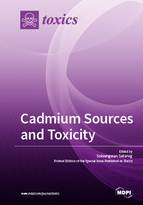Cadmium Sources and Toxicity
A special issue of Toxics (ISSN 2305-6304). This special issue belongs to the section "Toxicology".
Deadline for manuscript submissions: closed (1 July 2018) | Viewed by 62951
Special Issue Editor
Interests: epidemiology of cadmium toxicity; genetic and nutritional influence of cadmium toxicity outcomes; cadmium toxicity in at-risk subpopulations; novel methods of measuring cadmium in tissues; reverse dosimetry
Special Issues, Collections and Topics in MDPI journals
Special Issue Information
Dear Colleagues,
Cadmium is an environmental toxicant with high toxicity potential due to its non-biodegradability, coupled with high rates of soil-to-plant transference. It is estimated that 40–60% of dietary cadmium intake in the average consumer comes from dietary staples, such as rice, potatoes, and wheat, while shellfish, crustaceans, molluscs, offal and spinach form the remaining dietary sources. The divalent metal transporter, DMT1, the primary iron transporting protein in the intestine, is a major cadmium carrier, while ferroportin1 (FPN1) may mediate the transport of cadmium into the circulation. DMT1 expression is heightened in people with low body iron stores and iron deficiency; conditions common in women of reproductive age and children, rendering them at greatest risk of cadmium toxicity due to enhanced cadmium uptake. Chronic dietary cadmium exposure has been associated with increased risks of numerous diseases, including chronic kidney disease, hypertension, heart disease, osteoporosis, type 2 diabetes, liver inflammation, hearing loss, depression, macular degeneration, obstructive lung disease, infection with HBV and H. pylori, breast cancer, lung cancer and death from cancer and Alzheimer’s disease. These data signal that current population exposure levels have exceeded toxicity thresholds in many tissues, but the therapeutically effective metal chelating agents for reducing toxic Cd body burden are currently lacking.
This Special Issue will focus on highlighting timely research studies addressing sources and toxicity of cadmium. Topics are expected to include novel methods of measuring cadmium in tissues, validation of novel biomarkers of cadmium exposure, molecular basis for cadmium toxicity, interaction with zinc, copper, calcium, selenium and iron, strategies for minimizing cadmium in the global diet, strategies for reducing absorption of dietary cadmium, mitigation of cadmium toxicity, and the use of physiologically-based pharmacokinetic (PBPK) modeling in health risk assessment. Studies may include, but are not limited to toxicity in subpopulations at risk, such as young children who have greater food consumption rates per unit body mass and women of the reproductive age. Authors are invited and welcome to submit original research papers, reviews, and short communications.
Prof. Dr. Soisungwan Satarug
Guest Editor
Manuscript Submission Information
Manuscripts should be submitted online at www.mdpi.com by registering and logging in to this website. Once you are registered, click here to go to the submission form. Manuscripts can be submitted until the deadline. All submissions that pass pre-check are peer-reviewed. Accepted papers will be published continuously in the journal (as soon as accepted) and will be listed together on the special issue website. Research articles, review articles as well as short communications are invited. For planned papers, a title and short abstract (about 100 words) can be sent to the Editorial Office for announcement on this website.
Submitted manuscripts should not have been published previously, nor be under consideration for publication elsewhere (except conference proceedings papers). All manuscripts are thoroughly refereed through a single-blind peer-review process. A guide for authors and other relevant information for submission of manuscripts is available on the Instructions for Authors page. Toxics is an international peer-reviewed open access monthly journal published by MDPI.
Please visit the Instructions for Authors page before submitting a manuscript. The Article Processing Charge (APC) for publication in this open access journal is 2600 CHF (Swiss Francs). Submitted papers should be well formatted and use good English. Authors may use MDPI's English editing service prior to publication or during author revisions.
Keywords
- Cadmium toxicity threshold
- Cancer and chronic disease risks
- Cadmium exposure biomarkers
- Endogenous and exogenous antioxidants
- Metal chelators
- Metal dysregulation
- Metal transporters
- Phosphate fertilizer
- Pregnancy outcomes
- Safe intake level of dietary cadmium
- Soil contamination
- Synchroton and tissue metal analysis







